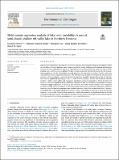| dc.description.abstract | Lakes are very important for domestic use, commercial purposes, and ecosystem sustenance; nevertheless, studies
on how different stressors influence water resources are limited, posing challenges in the planning and managing
of water resources. Lake Babati is one of the important lakes in the East African rift valley as a source of fish,
drinking water, and hippopotamus habitat. The lake level has consistently declined, threatening the life of organ-
isms depending on the lake. Nevertheless, no study postulated the reasons for its decline. Therefore, this study
used statistical methods, regression analysis and HEC-HMS hydrological model to investigate the association and
sensitivity of the hydrological components driving the lake level variability. Results showed that the Lake Ba-
bati level was significantly declining (p < 0.01) at a rate of 0.025 m yearly. The lake level variability was most
sensitive to inflow, while outflow and evaporation had almost equivalent magnitude in driving the lake level
variability and direct rainfall had the least influence. Although the lake level variability corresponded to changes
in the basin supply components, the declining lake level trend was neither directly related to lake evaporation
nor inflow as both parameters showed no significant trends. Furthermore, groundwater abstraction within the
lakeshore is smaller than lake evaporation and is unlikely the main driver of the decline in lake level. Therefore,
the declining lake level seemed related to the spillway outflow, which had been improved to avoid lake flooding
resulting in large outflow during the peak seasons and probably the reason for the significant decline in the lake
levels even in the rainy seasons. This study benchmarked the most sensitive hydrological drivers influencing lake
level whose accurate monitoring and management could rescue the situation | en_US |

